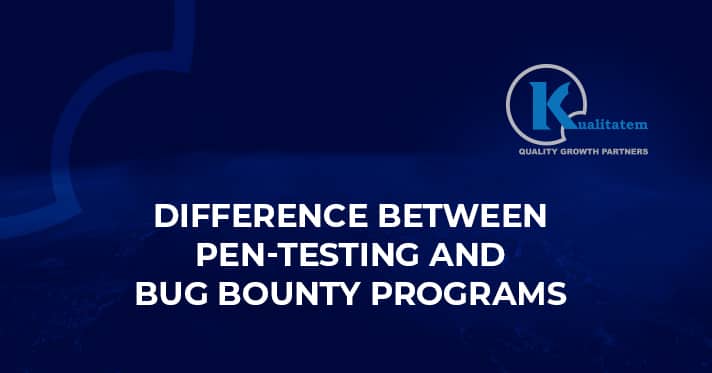Difference Between Pen-testing And Bug Bounty Programs

- February 25, 2020
- HibaSulaiman
Are you wondering what is the right way to test the security of a website or software application? When to choose an automated scan, penetration test or a bug bounty program? And why is it not recommended to rely on internal testing? Well, let’s discuss all the possibilities and find a solution. In the world of IT, there are only a few methodologies to test the security of web or mobile applications. While some companies neglect security and consider installing an antivirus program sufficient for cyber-protection, modern organizations know that they need to invest more time and money to ensure cybersecurity.
Cybercrime is spreading like an epidemic and attackers are growing more intelligent than ever before. Companies are now devising business strategies in accordance with cyber security needs to prevent and mitigate the risks of cyberattacks. On the contrary, many companies fail to place security checks and fall for phishing attacks due to their negligence towards advanced security measures. Since attackers are more sophisticated and discover new ways to attack systems, companies need to come up with innovative solutions. Proactive solutions like penetration testing are important to identify vulnerabilities and recommend solutions to deal in critical situations. For this purpose, organizations should hire a penetration testing company and ensure that a thorough scan of their systems and software is performed.
What Is A Penetration Test?
A penetration test is a one-time automated test of an organization’s IT security using specialized scans and tools focusing on the most critical vulnerabilities. It provides a detailed report on security vulnerabilities in a system, highlighting their impact on the overall security stature of an organization. But it is different from a vulnerability scan.
Vulnerability Scan
Vulnerability assessment or vulnerability scan is an automated test to identify the known vulnerabilities of a product resulting in a list of vulnerabilities with their location, but it is not a complete penetration test. However, pen-tests have a broader scope and besides listing the list of vulnerabilities, it highlights what the system can do. In addition, pen-tests provide verification of the system vulnerabilities found manually.
What Is A Bug-Bounty Program?
A bug bounty program offers a reward for security vulnerabilities discovered within a set scope. They allow independent hackers to perform security testing on web platforms and applications for a reward. This program utilizes paying for valid results, and they can be public or private. Bug bounty programs build upon the crowdsourced security model that leverages a community of white hat hackers to discover vulnerabilities across multiple attack surfaces. It is a continuous security testing technique that allows businesses to prevent cyber-attacks and data theft. Ethical hackers carry out security testing and are rewarded for finding errors and vulnerabilities in systems and applications.
Pen Test VS Bug Bounty Program
When an organization decides to conduct a pen-test, it should follow a structured approach to security testing. The main aim of a penetration testing company is to find all possible vulnerabilities that can be found on the platform that is tested. Let’s have a look at the advantages to clearly define the difference between these two approaches:
Strict Compliance – The main advantage of a pen-test is its possibility to test those parts of an application that a company does not want to have publicly tested by ethical hackers in a bug bounty program. This allows a strong contract between the company that has its own testing team and the penetration testing firm. However, this is not possible in a bug bounty program.
Complexity – When one or more ethical hackers are employed in a pen-test, they will test different levels of a product. And they usually follow OWASP standards.
Cost – Pen-test is relatively higher in cost. This is a major problem for some organizations, especially smaller companies that cannot afford the pen tests. Whereas in case of a bug bounty program, a company sets the amount of the rewards and they pay only for valid vulnerabilities.
Rewards – Ethical hackers get paid for penetration tests, but not every vulnerability found in an application means a reward to hackers in a bug bounty program. There are certain rules for these programs that include the principle of paying the reward to the first one to report bugs. And in order to receive a reward, they need to confirm the vulnerability.
How To Choose?
Having said that, quality penetration tests are costly and time-limited. Pen testers perform these tests that charge relatively higher than the other ethical hackers. Additionally, they require both formal and technical settings of the test environments. However, they provide a complete view of the current security state of your software apps. A penetration testing company usually takes 1-2 weeks to prepare for a pen-test and record its report manually. It can even test unpublished sites, apps, and products that are not released in the market yet.
Conclusion
It would be a big mistake to consider a single approach to security testing. Proactively, it should be a complementary way of using a testing approach that has a higher level of online security. Before a software app is launched, internal testing should be performed, and then a complex pen test that reveals the major security vulnerabilities. Once these issues are resolved, the product should be available to the public in the form of a bug bounty program to be tested for its different components. The company decides whether to allow ethical hackers to a production or testing environment. It is essential that a bug bounty program takes place at least 3 – 6 months. It allows the recently registered hackers to alert the company of security bugs that need to be addressed. If an organization has a limited budget for security testing, then they should rely on bug bounty programs for testing their application’s vulnerabilities.











